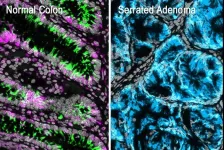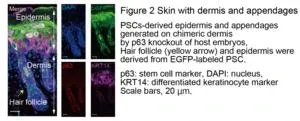(Press-News.org) Research led by Weill Cornell Medicine provides new evidence that most colorectal cancers begin with the loss of intestinal stem cells, even before cancer-causing genetic alterations appear. The results, published on May 29 in Developmental Cell, overturn the prevailing theory for colorectal tumor initiation and suggest new ways to diagnose the disease before it has a chance to become established.
“Colorectal cancer is very, very heterogeneous, which has made it difficult for many years to classify these tumors in order to inform therapy,” said senior author Dr. Jorge Moscat, Homer T. Hirst III Professor of Oncology in Pathology and Vice-Chair for Cell and Cancer Pathobiology in the Department of Pathology and Laboratory Medicine at Weill Cornell Medicine. This heterogeneity, the diverse characteristics of colorectal tumor cells in different patients and also within the same tumor, makes treatment particularly challenging.
Colorectal tumors can arise from two types of pre-cancerous polyps: conventional adenomas and serrated adenomas. Conventional adenomas were thought to develop from mutations in the normal stem cells that lie at the bottoms of intestinal crypts, pit-like structures in the lining of the intestine. Serrated adenomas, on the other hand, are associated with a different type of stem-like cell with fetal characteristics that appears mysteriously at the tops of the crypts. Scientists in the field have described these apparently distinct tumor-forming processes as “bottom-up” and “top-down.”
“We wanted to determine how those two routes really start and how they progress, so we can better understand their heterogeneity as the cancer progresses,” said co-senior author Dr. Maria Diaz-Meco, Homer T. Hirst Professor of Oncology in Pathology in the Department of Pathology and Laboratory Medicine at Weill Cornell Medicine and a member of the Meyer Cancer Center at Weill Cornell Medicine. That’s particularly important for serrated tumors, which doctors sometimes miss because of their initial flat shape, and which can become aggressive cancers later.
The co-first authors are Dr. Hiroto Kinoshita and Dr. Anxo Martinez-Ordoñez, postdoctoral associates in the Department of Pathology and Laboratory Medicine at Weill Cornell Medicine.
Getting to the Bottom of Colorectal Cancer
The researchers previously found that many human colorectal tumors of both origins have abnormally low levels of proteins called atypical protein kinase C (aPKC). The new study investigated what happens when the aPKC genes are inactivated in animal models and cultured intestinal organoids.
“We approached this project with the bottom-up and top-down theories, but we were surprised to find that both tumor types showed loss of intestinal stem cells after aPKC genes were inactivated,” said Dr. Moscat, who is also a member of the Sandra and Edward Meyer Cancer Center at Weill Cornell Medicine.
The characteristic top-side stem cells on serrated adenomas only arise after the normal stem cells at the bottom of the crypt die, throwing the structure of the entire crypt into disarray. “So, the conventional cancer is bottom-up, and the serrated cancer is also bottom-up,” said Dr. Moscat.
The findings suggest a new unified model for the initiation of colorectal cancer where damage to the intestinal crypts causes a decrease in aPKC protein expression, followed by loss of the normal stem cells at the bottom of the crypt. Without those stem cells, the crypt cells can’t regenerate. To survive, the structure can spawn either a replacement population of regenerative stem cells at the bottom, or more fetal-like stem cells at the top. These replacement cells may then lead to cancer.
“If we can better understand how aPKC protein expression is regulated, we could control and prevent tumor development, and also better understand the progression of tumors,” said Dr. Diaz-Meco. The team is now looking at aPKC expression patterns in human tumors at different stages, with hopes of developing molecular tests that could be used to detect tumors earlier, classify tumors in patients and develop better treatments.
Many Weill Cornell Medicine physicians and scientists maintain relationships and collaborate with external organizations to foster scientific innovation and provide expert guidance. The institution makes these disclosures public to ensure transparency. For this information, please see profiles for Dr. Jorge Moscat and Dr. Maria Diaz-Meco.
This research was supported in part by the National Cancer Institute of the National Institutes of Health under awards numbers, R01CA265892, R01CA250025, R01CA275846, R01CA246765, R50CA265332 and R50CA283476.
END
Identifying the initial steps in colorectal cancer formation
2024-05-29
ELSE PRESS RELEASES FROM THIS DATE:
hnRNPM, a guardian of the integrity of cellular protein production
2024-05-29
Researchers at Baylor College of Medicine and collaborating institutions have discovered that a protein called hnRNPM helps protect the integrity of the process cells use to make proteins. hnRNPM works by preventing the cell from making mistakes while it is putting together the different components leading to newly produced proteins. In cancer cells, loss of hnRNPM triggers an interferon immune response, suggesting that this protein may hold clinical promise. The findings appeared in Molecular Cell.
“Synthesizing a protein is like putting together the different parts of a machine. If during the assembly process parts that do not belong are incorporated ...
Children often exposed to problematic click bait during YouTube searches
2024-05-29
ANN ARBOR, Mich. – When a child peruses YouTube, the content recommended to them is not always age appropriate, a new study suggests.
Researchers mimicked search behaviors of children using popular search terms, such as memes, Minecraft and Fortnite, and captured video thumbnails recommended at the end of each video.
Among the 2,880 thumbnails analyzed, many contained problematic click bait, such as violence or frightening images, according to the Michigan Medicine led research in JAMA Network Open.
“Children spend a significant amount of time on free video sharing platforms that ...
Modular, scalable hardware architecture for a quantum computer
2024-05-29
CAMBRIDGE, MA — Quantum computers hold the promise of being able to quickly solve extremely complex problems that might take the world’s most powerful supercomputer decades to crack.
But achieving that performance involves building a system with millions of interconnected building blocks called qubits. Making and controlling so many qubits in a hardware architecture is an enormous challenge that scientists around the world are striving to meet.
Toward this goal, researchers at MIT and MITRE have demonstrated a scalable, modular hardware platform that ...
Landmark study is step towards energy-efficient quantum computing in magnets
2024-05-29
Researchers from Lancaster University and Radboud University Nijmegen have managed to generate propagating spin waves at the nanoscale and discovered a novel pathway to modulate and amplify them.
Their discovery, published in Nature, could pave the way for the development of dissipation free quantum information technologies. As the spin waves do not involve electric currents these chips will be free from associated losses of energy.
The rapidly growing popularity of artificial intelligence comes with an increasing desire for fast and energy efficient computing devices and calls for novel ...
Grow the skin you’re in: in vivo generation of chimeric skin grafts
2024-05-29
Researchers from Tokyo Medical and Dental University (TMDU) find that donor keratinocytes injected into mouse embryos form sheets of epidermis that can be used as autologous skin grafts
Tokyo, Japan – Skin grafting is an essential procedure used to treat severe skin wounds. In the case of extensive wounds, however, it can be challenging to harvest enough donor skin, and generating artificial skin substitutes that include hair follicles and sweat glands and can engraft on deep wounds has not been successful. Now, researchers from Japan report a new way to “grow your own” donor skin that could help improve the success of skin graft generation.
In a study published last ...
BGU researchers and colleagues discover therapeutic potential of increasing MIF protein levels as a novel approach for treating amyotrophic lateral sclerosis (ALS)
2024-05-29
BEER-SHEVA, Israel, May 29, 2024 – A recent collaborative research endeavor, published in the prestigious Cell Press journal Cell Reports Medicine, highlights a promising therapeutic avenue for amyotrophic lateral sclerosis (ALS). Led by researchers from Ben-Gurion University of the Negev in conjunction with counterparts from Germany, the USA, and Canada, the study delves into the potential of augmenting macrophage migration inhibitory factor (MIF) protein levels as a novel approach to tackling ALS.
ALS, often referred to as Lou Gehrig's disease, is a devastating neurodegenerative condition characterized by the progressive loss of motor neurons, leading to muscle ...
War magnifies politicians’ gendered behavior, public biases, research finds
2024-05-29
Women’s participation in politics is essential to advancing women’s rights and contributes to countries’ overall stability and economic prosperity. According to a 2023 report by UN Women and the Inter-Parliamentary Union, one-fourth of parliamentary positions worldwide are held by women. Although current representation is still far from equal, it represents a significant increase over the last 20 years.
However, a new paper from Washington University in St. Louis — published ...
International experts reach consensus on the labeling of spatial neglect
2024-05-29
East Hanover, NJ, May 29, 2024 — A consensus has been achieved by an international team of rehabilitation researchers and clinicians on the standardized labeling of spatial neglect, a common disorder following neurological injury, which is characterized by a lack of awareness or response to objects or stimuli on the side opposite a brain lesion. The panel reached a 75% consensus to adopt "spatial neglect" as the standard term for the disorder.
The consensus paper, titled “An International and ...
Gaps in transition from pediatric to adult care for individuals living with sickle cell disease associated with more hospital visits
2024-05-29
(WASHINGTON, May 29, 2024) – Individuals living with sickle cell disease (SCD) who experience a delay of more than six months in transitioning from pediatric to adult care are twice as likely to be hospitalized compared to those who transition in less than two months, according to a study published in Blood Advances.
SCD is the most common inherited red blood cell disorder in the United States, affecting an estimated 100,000 people. According to the Centers for Disease Control and Prevention, SCD affects one out of every 365 Black or African American births and one out of every 16,300 ...
STEP Demo supercritical CO2 pilot plant generates electricity for the first time
2024-05-29
SAN ANTONIO — May 29, 2024 —The Supercritical Transformational Electric Power (STEP) Demo pilot plant has generated electricity for the first time using supercritical carbon dioxide (sCO2) power cycles. The $169 million, 10-megawatt sCO2 facility at Southwest Research Institute (SwRI) in San Antonio is demonstrating next-generation power production technology in a project led by GTI Energy in collaboration with SwRI, GE Vernova, the U.S. Department of Energy/National Energy Technology Laboratory (U.S. DOE/NETL), and several industry participants.
“The impact of demonstrating that the sCO2 technology works cannot be overstated,” said SwRI Project Manager Dr. Jeff ...







